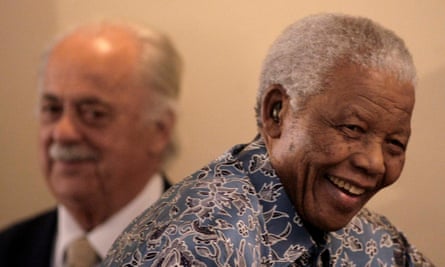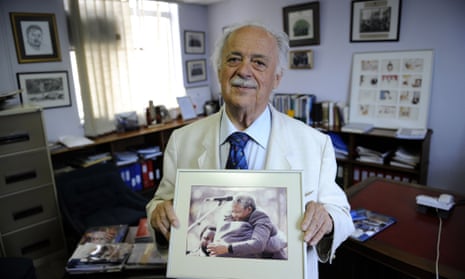George Bizos, who has died aged 92, was the best known lawyer in South Africa. To many, his stout and slightly rumpled figure represented all that was best about the law, a man who was seemingly always there, attack or defence, when a wrong had been committed or human rights trampled on.
His most famous client was Nelson Mandela. At the Rivonia trial of 1963-64– in which the leadership of the African National Congress were tried for sabotage, a capital offence – Bizos made a small, but significant intervention, which may have saved Mandela’s life. It came when Mandela was preparing his famous statement from the dock with the help of lawyers and others. The statement ended with the words “it is an ideal for which I am prepared to die”.
Bizos, who was junior counsel at the time, objected. As he was to say later in his memoirs: “I was shocked by his closing words; that he was ready to die for what he had done. Surely this would be viewed as a challenge, irresistible to the prosecution, the judge and the government? I argued that surely Nelson wanted to live and accomplish what he and his organisation strove for.” The defence team and Mandela were split on the point, until Bizos proposed inserting the words “if needs be”.
“What influenced me here was an argument that Socrates might have saved his life if he had not challenged the Athenian jury in so resolute a manner,” said Bizos, who loved “the ancients”.
There was something very English about Bizos, and it would come as a slight surprise to some to realise he was Greek. He was to title his memoirs Odyssey to Freedom (2007), which was apposite when one considers the journey he made from the small village of his birth, Vasilitsi, on the Peloponnese peninsula, to the southern tip of Africa, where he found friendship with Mandela, who became the most famous prisoner in the world.
Bizos was the son of the Vasilitsi mayor, Antonios, and his wife, Anastasia (nee Tomaras). When George was 13, Antonios decided to help a group of seven New Zealand soldiers, who were hiding out from the Nazis in the hills near Vasilitsi. He had bought a small boat to facilitate the escape and, after something of a family squabble, George was allowed to go as well. After three days, however, they were picked up by an allied ship, HMS Kimberley, and were dropped off at Alexandria.
From Egypt, George and his father sailed to Durban on the SS Ile de France – which was loaded with allied troops suffering tuberculosis and Italian PoWs – and were accepted as refugees. They were sent to Johannesburg where, speaking neither English nor Afrikaans, George battled to get into school and his father to get work. But they were taken in by the Greek community.
In 1948 Bizos was admitted to the University of the Witwatersrand, studying law – he had been turned down by the medical school, because his marks were not good enough – and in 1954 to the Johannesburg bar. At Wits he had met Mandela, a part-time student at the university. Bizos quickly found himself handling political cases, and was regularly briefed by Mandela and Oliver Tambo’s law firm.

In the years that followed, he was involved in almost every case of political significance. In 1966, Bizos defended Bram Fischer QC, the leader of the Rivonia defence team and, unknown to most, also leader of the South African Communist party, who – soon after the Rivonia trial – had been arrested for contravening the Suppression of Communism Act. He appeared in the Delmas treason trial, 1985-89, the long-running trial of 22 activists. He was counsel at the inquests into the deaths in detention of the anti-apartheid activists Steve Biko and Ahmed Timol, and Dr Neil Aggett, arrested for his union activities. He also appeared for Winnie Mandela in widely differing circumstances and later for the Zimbabwean opposition politician Morgan Tsvangirai.
To hear that collective grunt of satisfaction from a black audience in the public gallery as he made a point with a withering air – against a rightwing politician accused of murder, perhaps, or a policeman accused of torture – was to appreciate the value of the law as theatre. He was Rumpole, not of the Bailey, but of South Africa, and South Africa was glad of it.
Outside the courtroom Bizos played a part in the negotiations for the release of political prisoners, including Mandela in 1990; and he was one of the team drafting the new constitution that passed into law in 1996. In 1994 he was appointed by Mandela to the Judicial Service Commission, which had the job of appointing and promoting judges, and served until 2009.
In the aftermath of liberation, Bizos could have had almost any judicial appointment – including seats on the bench, or in cabinet – but he was seemingly content to remain as counsel.
He met his wife, Arethe (nee Daflos), a fellow Greek, on the upstairs deck of a city tram in Johannesburg while a student, and they married in 1948. She died in 2017. Bizos is survived by their three sons, Kimon, Damon and Alexi, and seven grandchildren.
George Bizos, lawyer, born 14 November 1927; died 9 September 2020
